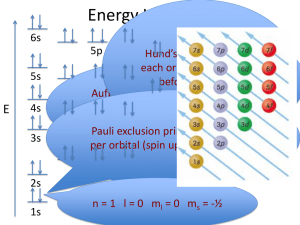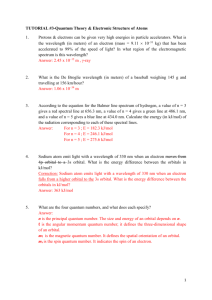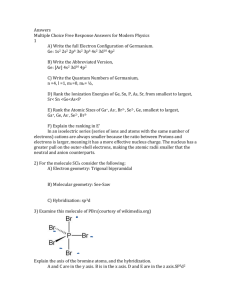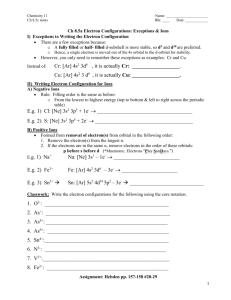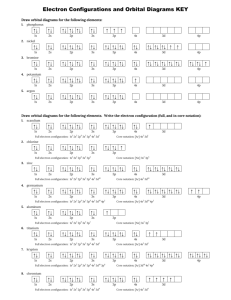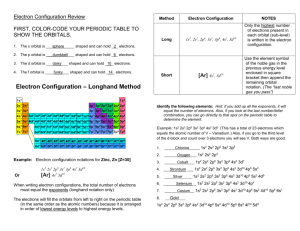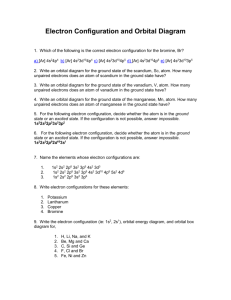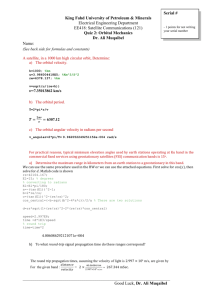Ground State Electron Configurations • The actual wavefunction of a
advertisement
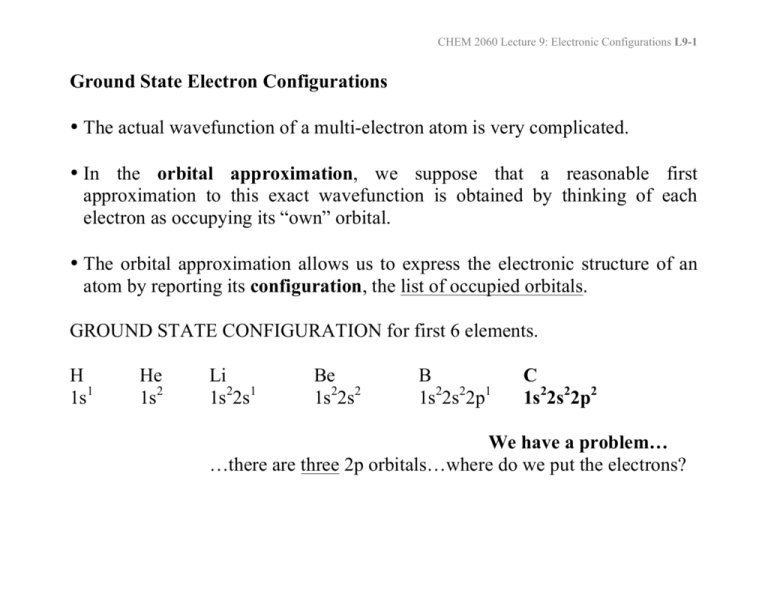
CHEM 2060 Lecture 9: Electronic Configurations L9-1 Ground State Electron Configurations • The actual wavefunction of a multi-electron atom is very complicated. • In the orbital approximation, we suppose that a reasonable first approximation to this exact wavefunction is obtained by thinking of each electron as occupying its “own” orbital. • The orbital approximation allows us to express the electronic structure of an atom by reporting its configuration, the list of occupied orbitals. GROUND STATE CONFIGURATION for first 6 elements. H 1s1 He 1s2 Li 1s22s1 Be 1s22s2 B 1s22s22p1 C 1s22s22p2 We have a problem… …there are three 2p orbitals…where do we put the electrons? CHEM 2060 Lecture 9: Electronic Configurations L9-2 How can we fill 2 electrons into the three p orbitals, obeying the Pauli principle? Identify the ground state using Hund’s rule (maximum multiplicity)… …maximum # of parallel spins results in lowest e- - e- repulsion. The above diagram roughly depicts the relative energy difference between these three ways of filling 2 electrons into the three p orbitals. 1 1 1 1 1 1 Ground State: 1s22s22px 2py (or 1s22s22px 2pz or 1s22s22py 2pz ) [CAUTION: these don’t explicitly state the electron’s spin!] CHEM 2060 Lecture 9: Electronic Configurations L9-3 The 4th Quantum Number In order to discuss atomic orbital energies, we use 3 quantum numbers: Principal n (majority contribution to energy) Angular momentum l (orbital shape) Magnetic ml (orbital orientation) These 3 quantum numbers are the spatial quantum numbers. ⇒ together, they describe the 3D appearance of the orbital in space ⇒ the spatial probability distribution of an e- described by that orbital The 4th quantum number is necessary to fully describe an e- in an orbital. Spin ms = + ½, - ½ ms (orientation of electron “spin”) MEANING? An electron is either “spin up” or “spin down”. α β The explanation of Hund’s rule is complicated, but it reflects the quantum mechanical property of spin correlation, that electrons with parallel spins have a tendency to stay well apart and hence repel each other less. CHEM 2060 Lecture 9: Electronic Configurations L9-4 electron-electron repulsions and the Aufbau principle We have already seen that e-e repulsions affect: 1) Ionization Potentials (See Li) 2) Electron Affinities (See Cl & F) 3) Ground State Configurations (e.g., C) Let’s look again at the ordering of atomic orbitals, paying particular attention to the 3d and 4s in transition metals. CHEM 2060 Lecture 9: Electronic Configurations L9-5 The Electronic Configurations of the Elements. HOMEWORK FOR TUTORIAL: Fill in electrons for C, N, O, F, Ne, Na & Mg CHEM 2060 Lecture 9: Electronic Configurations L9-6 Electronic Configuration Z 1 2 3 4 5 6 7 8 9 10 11 12 13 14 15 16 17 18 19 20 21 22 23 neutral H 1s1 He 1s2 Li [He] 2s1 Be [He] 2s2 B [He] 2s2 2p1 C [He] 2s2 2p2 N [He] 2s2 2p3 O [He] 2s2 2p4 F [He] 2s2 2p5 Ne [He] 2s2 2p6 Na [Ne] 3s1 Mg [Ne] 3s2 Al [Ne] 3s2 3p1 Si [Ne] 3s2 3p2 P [Ne] 3s2 3p3 S [Ne] 3s2 3p4 Cl [Ne] 3s2 3p5 Ar [Ne] 3s2 3p6 K [Ar] 4s1 Ca [Ar] 4s2 Sc [Ar] 3d1 4s2 Ti [Ar] 3d2 4s2 V [Ar] 3d3 4s2 +ve ion 1s1 1s2 [He] 2s1 [He] 2s2 [He] 2s2 2p1 [He] 2s2 2p2 [He] 2s2 2p3 [He] 2s2 2p4 [He] 2s2 2p5 [Ne] [Ne] 3s1 [Ne] 3s2 [Ne] 3s2 3p1 [Ne] 3s2 3p2 [Ne] 3s2 3p3 [Ne] 3s2 3p4 [Ne] 3s2 3p5 [Ar] [Ar] 4s1 [Ar] 3d1 4s1 [Ar] 3d2 4s1 [Ar] 3d4 partial filling of both 3d and 4s in Sc+ partial filling of both 3d and 4s in Ti+ 4s is empty for V+ CHEM 2060 Lecture 9: Electronic Configurations L9-7 24 25 26 27 28 29 30 31 32 33 34 35 36 37 38 39 40 41 42 43 44 45 46 47 48 Cr Mn Fe Co Ni Cu Zn Ga Ge As Se Br Kr Rb Sr Y Zr Nb Mo Tc Ru Rh Pd Ag Cd [Ar] 3d5 4s1 [Ar] 3d5 4s2 [Ar] 3d6 4s2 [Ar] 3d7 4s2 [Ar] 3d8 4s2 [Ar] 3d10 4s1 [Ar] 3d10 4s2 [Ar] 3d10 4s2 4p1 [Ar] 3d10 4s2 4p2 [Ar] 3d10 4s2 4p3 [Ar] 3d10 4s2 4p4 [Ar] 3d10 4s2 4p5 [Ar] 3d10 4s2 4p6 [Kr] 5s1 [Kr] 5s2 [Kr] 4d1 5s2 [Kr] 4d2 5s2 [Kr] 4d4 5s1 [Kr] 4d5 5s1 [Kr] 4d5 5s2 [Kr] 4d7 5s1 [Kr] 4d8 5s1 [Kr] 4d10 [Kr] 4d10 5s1 [Kr] 4d10 5s2 [Ar] 3d5 only 1e- in 4s for Cr…4s empty for Cr+ [Ar] 3d5 4s1 partial filling of both 3d and 4s in Mn+ [Ar] 3d6 4s1 partial filling of both 3d and 4s in Fe+ [Ar] 3d8 4s is empty for Co+ [Ar] 3d9 4s is empty for Ni+ [Ar] 3d10 1e- in 4s for Cu…4s empty for Cu+ [Ar] 3d10 4s1 [Ar] 3d10 4s2 [Ar] 3d10 4s2 4p1 [Ar] 3d10 4s2 4p2 [Ar] 3d10 4s2 4p3 [Ar] 3d10 4s2 4p4 [Ar] 3d10 4s2 4p5 [Kr] [Kr] 5s1 [Kr] 5s2 4d is empty for Y+…different from Sc+ [Kr] 4d2 5s1 partial filling of both 4d and 5s in Zr+ [Kr] 4d4 only 1e- in 5s for Nb.. 5s empty in Nb+ [Kr] 4d5 only 1e- in 5s for Mo.. 5s empty Mo+ [Kr] 4d5 5s1 partial filling of both 4d and 5s in Tc+ [Kr] 4d7 [Kr] 4d8 [Kr] 4d9 5s empty in both Pd and Pd+ [Kr] 4d10 1e- in 5s for Ag…5s empty for Ag+ [Kr] 4d10 5s1 CHEM 2060 Lecture 9: Electronic Configurations L9-8 There are several exceptions (of different types) to the Aufbau principle. The oversimplified filling rules that we learned in first year chemistry work up to Z = 20 (calcium), but are no longer accurate for heavier elements where the energy difference between n and n+1 is smaller. 3d and 4s orbitals (K, Ca, Sc, Ti, V, Cr, Mn, Fe, Co Ni, Cu, Zn) In atoms (charge = 0), 4s fills first…we say that “4s is lower than 3d” EXCEPTIONS occur for Cr and Cu. Chromium Copper [Ar] 3d5 4s1 [Ar] 3d10 4s1 half-filled 3d orbital shell filled 3d orbital shell WHY? Because we are being “naïve” by simply referring to the energy of orbitals! By saying“4s is lower than 3d”, we are neglecting the impact of e-e repulsion! CHEM 2060 Lecture 9: Electronic Configurations L9-9 The ground state electronic configurations of the 0, +1, and +2 oxidation states of the element scandium (Sc) provide a really good example for this argument. Sc Sc+ Sc2+ [Ar] 3d1 4s2 [Ar] 3d1 4s1 [Ar] 3d1 ⇒ The 3d and 4s orbitals are close in energy… …the energy difference is small enough that the effect of e--e- repulsion dictates the ground state configurations. There are a number of experimental values that can help probe this issue: Experimental energy required to excite one electron from 4s to 3d in Sc: Sc ([Ar]3d14s2) → Sc ([Ar]3d24s1) ΔE = 2.03 eV Experimental ionization potentials from 3d versus from 4s in Sc: Sc ([Ar]3d14s2) → Sc+ ([Ar]3d14s1) + eIP4s = 6.62 eV Sc ([Ar]3d14s2) → Sc+ ([Ar]4s2) + eIP3d = 7.98 eV CHEM 2060 Lecture 9: Electronic Configurations L9-10 We are now left with a dilemma… If it is easier to remove an electron from the 4s orbital than from the 3d orbital, shouldn’t that mean that the 3d orbital is lower in energy than the 4s? Why, then, is the 4s orbital filled before the 3d orbital? ANSWER: It is more accurate to consider the relative energies of electronic configurations than of atomic orbitals. In other words, the energies of the electronic configurations ultimately dictate the apparent ordering of the atomic orbital energies. The 4s orbital is more diffuse that the 3d orbital. But the 4s orbital also penetrates to the nucleus better than the 3d orbital. CHEM 2060 Lecture 9: Electronic Configurations L9-11 For most of the 1st row transition metal elements, the ground state is: [Ar]3dx4s2 (4s fills first) …because e-e repulsion is decreased by filling the diffuse 4s orbital first. Note exceptions often occur with: Exactly ½-filled and full shells Chromium 3d5 4s1 Copper 3d10 4s1 These exceptions reflect a quantum mechanical stabilization of exactly ½-filled or full (sub)shells. CHEM 2060 Lecture 9: Electronic Configurations L9-12 For ALL of the 1st row transition metal dications (or higher oxidation states), the ground state is: [Ar]3dx (4s is empty) When we start removing electrons from the system, we increase the overall nuclear charge “felt” by all the remaining electrons… …we’ve decreased the shielding! As a result, the atomic orbitals contract (become less diffuse). The reduction in the “diffuse-ness” of the 4s orbital results in an increase in e-e repulsion between electrons occupying this orbital. For M+, this reduction in the “diffuse-ness” of the 4s orbital does not always outweigh the “natural” orbital energy ordering (3d lower than 4s). For M2+, M3+, M4+, etc., the result is that occupation of only the 3d orbitals results in a lower energy electronic configuration…we say “3d is lower than 4s”. CHEM 2060 Lecture 9: Electronic Configurations L9-13
